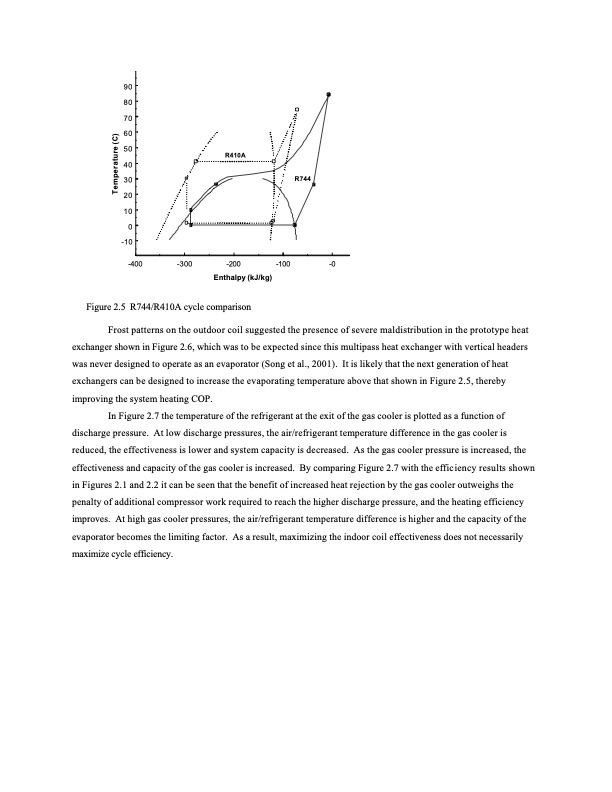
PDF Publication Title:
Text from PDF Page: 019
90 80 70 60 50 40 30 20 10 0 -10 -400 -300 R410A -200 -100 Enthalpy (kJ/kg) R744 Figure 2.5 R744/R410A cycle comparison Frost patterns on the outdoor coil suggested the presence of severe maldistribution in the prototype heat exchanger shown in Figure 2.6, which was to be expected since this multipass heat exchanger with vertical headers was never designed to operate as an evaporator (Song et al., 2001). It is likely that the next generation of heat exchangers can be designed to increase the evaporating temperature above that shown in Figure 2.5, thereby improving the system heating COP. In Figure 2.7 the temperature of the refrigerant at the exit of the gas cooler is plotted as a function of discharge pressure. At low discharge pressures, the air/refrigerant temperature difference in the gas cooler is reduced, the effectiveness is lower and system capacity is decreased. As the gas cooler pressure is increased, the effectiveness and capacity of the gas cooler is increased. By comparing Figure 2.7 with the efficiency results shown in Figures 2.1 and 2.2 it can be seen that the benefit of increased heat rejection by the gas cooler outweighs the penalty of additional compressor work required to reach the higher discharge pressure, and the heating efficiency improves. At high gas cooler pressures, the air/refrigerant temperature difference is higher and the capacity of the evaporator becomes the limiting factor. As a result, maximizing the indoor coil effectiveness does not necessarily maximize cycle efficiency. -0 Temperature (C)PDF Image | Comparison of R744 and R410A

PDF Search Title:
Comparison of R744 and R410AOriginal File Name Searched:
CR039.pdfDIY PDF Search: Google It | Yahoo | Bing
CO2 Organic Rankine Cycle Experimenter Platform The supercritical CO2 phase change system is both a heat pump and organic rankine cycle which can be used for those purposes and as a supercritical extractor for advanced subcritical and supercritical extraction technology. Uses include producing nanoparticles, precious metal CO2 extraction, lithium battery recycling, and other applications... More Info
Heat Pumps CO2 ORC Heat Pump System Platform More Info
| CONTACT TEL: 608-238-6001 Email: greg@infinityturbine.com | RSS | AMP |